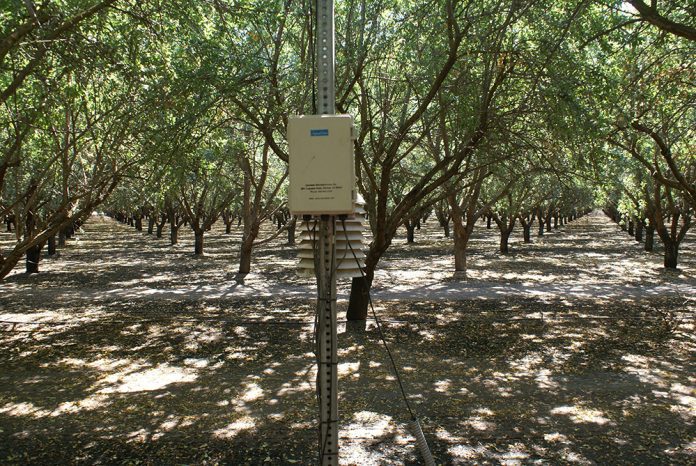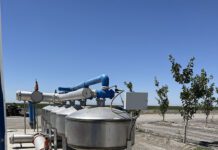
I was speaking to a friend of mine recently who happens to be a great farmer. He had a quote I had never heard before but one that is pertinent to farming. His name is Tim Larson, and he said, “I don’t have 30 years of farming experience; I have 30 different farming experiences.” No truer words have ever been spoken. Every year is different. Even in typical drought years, the timing when different heat waves hit us, and their severity, change our game plan a bit…. Or they should. This year, with rainfall and snowpack levels we haven’t seen in a while, we are going to have to overcome and adapt. CCA Derek Sissom likes to say, “It’s NOT business as usual!”
If there ever was a time to get your soil monitoring game on, this is the year. I have heard reports of sub-soil water levels back up to 8 feet in the Dos Palos, Calif. area. My well in Madera, Calif. is up 45 feet from its lowest depths last summer. Typically, here in the Central Valley, we don’t see the levels of standing water in our wells go up for a year after a big snowpack, if at all. This year, it’s up just from rainwater. Many of my farmers in Kings and northern Kern counties will not be able to farm this year at all. We haven’t seen this since 1983. It’s going to take a lot of work to get back to “normal.”
Monitor Your Soil this Year
There are significant choices on the market for soil moisture monitoring systems. Being a geeky tech-type of farmer, I originally bought a simple three-probe monitoring box that I installed in my field on a spot I thought represented an average of soil type and CEC. I had to physically connect a PC to the port every time I wanted a reading, but it would give me a good amount of detail of what my soil profile looked like. But it was an average and for that spot. Better, but not perfect. It helped in knowing when to turn on the water and for how long. It cost less than $1500 10 years ago. I then purchased two sensors connected by cell that would send information to my phone, in real time, with sensors every 6 inches down to 4 feet.
This changed the game on knowing what the saturation levels were at any given time and how quickly I pushed water through the profile during every irrigation. Since then, I have installed a suite of data collection from Semios that monitors soil moisture, temps in canopy and above, full weather stations and a dendrometer that measures fractions of movement in trunk size. It not only helps me dial in my irrigation and, more importantly, fertigation, it confirms my trees are actually responding to my inputs and continually growing.
These systems aren’t cheap, but in typical years, the water savings can be tremendous. Input use and effectiveness is nothing to ignore. A 70- to 100-unit nitrogen savings in input costs in a year mean a lot to me. Going from 250 units to 150 is a big deal. At over $400/ton for UAN-32, that’s $160 to $230/acre you could potentially save. And that’s just in nitrogen. Knowing you are applying nutrients to a level where all your feeder roots are and allowing it to stay there for a few days before another irrigation set and ensuring more uniform absorption and efficiency can be critical. This year, water will be as cheap as it has been in a long time. However, most of us still have to pump it, and our electricity providers haven’t been cutting their prices at all. Now factor in the cost to turn those pumps on and calculate reducing those times by say 30%. Another significant savings. Imagine going from 4 acre-feet to an efficient 3 acre-feet of applied water.
I also purchased an injection system from Empirical Ag for my farm to make it easy to apply nutrients in specific amounts at specific times in my set. Being able to program and control four different tanks of nutrients with my water every time the system goes on has been a godsend. My nutrient budgets have gone down as have my irrigation costs. These system costs took some calculations to see if they penciled out, but they have paid for themselves since I have installed them. And they are only a few years old. Specifically, pistachios don’t like wet feet. I may not have to turn my well on for an irrigation event until well after Tax Day. But that won’t stop me from applying nutrition early to ensure my trees have what they need to start the season right. A short set can get nutrients into the soil, just down to the feeder root level, and let Mother Nature do the rest. It’s tough for a tree to get the phosphorus it needs early for energy when it’s wet and cold. A little shot of orthophosphate goes a long way, applied correctly in the spring.
Many of my farmers have been panicking they won’t be able to get enough nitrogen applied to hit the typical recommendation for N. Especially when N and P start high in the spring tissues. Applying a 50-unit slug to wet soil early in the season is not the answer. You’re wasting your money on all but the heaviest soils that might be able to hold that much N. And if it keeps raining, you’re washing a bunch of that nitrate right through the feeder roots. Applying 12 units per week in short sets will be much more effective. I’m hoping a bunch of you keep emailing or calling me and verifying these tactics work for you like they have for me and my clients.
When it’s not business as usual (and when is it ever usual anymore?), we must adapt. This year, more than others, we will have to be super vigilant to get things right. Technology may not be your specific answer, but it has made my life a lot easier. Farming is hard work. ‘Easy’ is not a typical part of our lifestyle, but being more efficient with our water and inputs should be. When it increases the bottom line, it makes the “experience” that much better.















